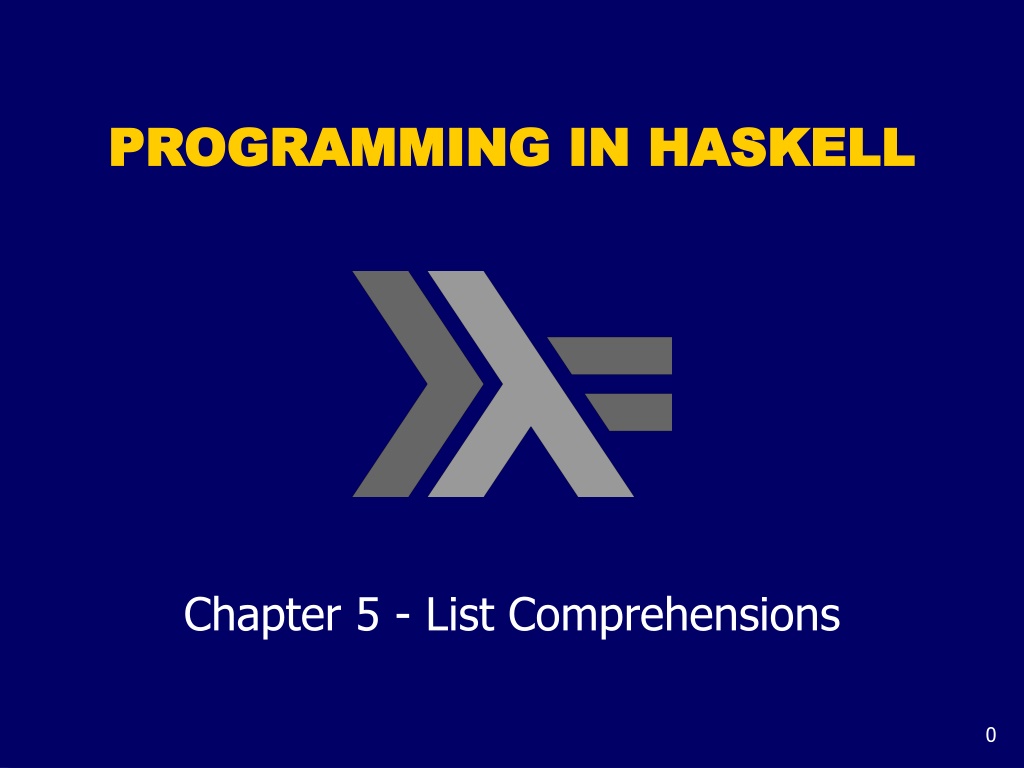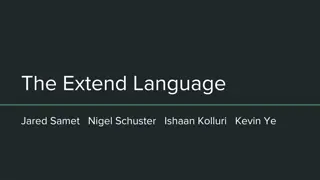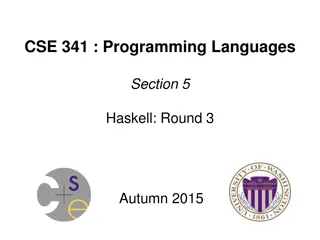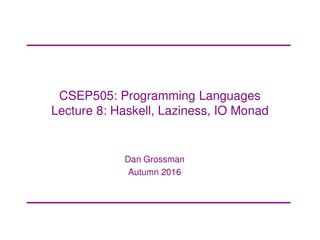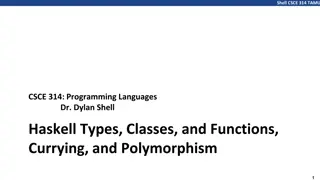Understanding List Comprehensions in Haskell Programming
In Haskell programming, list comprehensions provide a concise way to construct new lists from existing ones. By following comprehension notation similar to mathematics, you can generate sets and lists based on specified criteria. The order of generators and the use of dependent generators can significantly impact the output of your list comprehensions. This summary explores the key concepts and examples related to list comprehensions in Haskell programming.
Download Presentation

Please find below an Image/Link to download the presentation.
The content on the website is provided AS IS for your information and personal use only. It may not be sold, licensed, or shared on other websites without obtaining consent from the author. Download presentation by click this link. If you encounter any issues during the download, it is possible that the publisher has removed the file from their server.
E N D
Presentation Transcript
PROGRAMMING IN HASKELL PROGRAMMING IN HASKELL Chapter 5 - List Comprehensions 0
Set Comprehensions In mathematics, the comprehension notation can be used to construct new sets from old sets. {x2 | x {1...5}} The set {1,4,9,16,25} of all numbers x2 such that x is an element of the set {1 5}. 1
Lists Comprehensions In Haskell, a similar comprehension notation can be used to construct new lists from old lists. [x^2 | x [1..5]] The list [1,4,9,16,25] of all numbers x^2 such that x is an element of the list [1..5]. 2
Note: z The expression x [1..5] is called a generator, as it states how to generate values for x. z Comprehensions can have multiple generators, separated by commas. For example: > [(x,y) | x [1,2,3], y [4,5]] [(1,4),(1,5),(2,4),(2,5),(3,4),(3,5)] 3
z Changing the order of the generators changes the order of the elements in the final list: > [(x,y) | y [4,5], x [1,2,3]] [(1,4),(2,4),(3,4),(1,5),(2,5),(3,5)] z Multiple generators are like nested loops, with later generators as more deeply nested loops whose variables change value more frequently. 4
z For example: > [(x,y) | y [4,5], x [1,2,3]] [(1,4),(2,4),(3,4),(1,5),(2,5),(3,5)] x [1,2,3] is the last generator, so the value of the x component of each pair changes most frequently. 5
Dependant Generators Later generators can depend on the variables that are introduced by earlier generators. [(x,y) | x [1..3], y [x..3]] The list [(1,1),(1,2),(1,3),(2,2),(2,3),(3,3)] of all pairs of numbers (x,y) such that x,y are elements of the list [1..3] and y x. 6
Using a dependant generator we can define the library function that concatenates a list of lists: concat :: [[a]] [a] concat xss = [x | xs xss, x xs] For example: > concat [[1,2,3],[4,5],[6]] [1,2,3,4,5,6] 7
Guards List comprehensions can use guards to restrict the values produced by earlier generators. [x | x [1..10], even x] The list [2,4,6,8,10] of all numbers x such that x is an element of the list [1..10] and x is even. 8
Using a guard we can define a function that maps a positive integer to its list of factors: factors :: Int [Int] factors n = [x | x [1..n], n `mod` x == 0] For example: > factors 15 [1,3,5,15] 9
A positive integer is prime if its only factors are 1 and itself. Hence, using factors we can define a function that decides if a number is prime: prime :: Int Bool prime n = factors n == [1,n] For example: > prime 15 False > prime 7 True 10
Using a guard we can now define a function that returns the list of all primes up to a given limit: primes :: Int [Int] primes n = [x | x [2..n], prime x] For example: > primes 40 [2,3,5,7,11,13,17,19,23,29,31,37] 11
The Zip Function A useful library function is zip, which maps two lists to a list of pairs of their corresponding elements. zip :: [a] [b] [(a,b)] For example: > zip [ a , b , c ] [1,2,3,4] [( a ,1),( b ,2),( c ,3)] 12
Using zip we can define a function returns the list of all pairs of adjacent elements from a list: pairs :: [a] [(a,a)] pairs xs = zip xs (tail xs) For example: > pairs [1,2,3,4] [(1,2),(2,3),(3,4)] 13
Using pairs we can define a function that decides if the elements in a list are sorted: sorted :: Ord a [a] Bool sorted xs = and [x y | (x,y) pairs xs] For example: > sorted [1,2,3,4] True > sorted [1,3,2,4] False 14
Using zip we can define a function that returns the list of all positions of a value in a list: positions :: Eq a a [a] [Int] positions x xs = [i | (x ,i) zip xs [0..], x == x ] For example: > positions 0 [1,0,0,1,0,1,1,0] [1,2,4,7] 15
String Comprehensions A string is a sequence of characters enclosed in double quotes. Internally, however, strings are represented as lists of characters. "abc" :: String Means [ a , b , c ] :: [Char]. 16
Because strings are just special kinds of lists, any polymorphic function that operates on lists can also be applied to strings. For example: > length "abcde" 5 > take 3 "abcde" "abc" > zip "abc" [1,2,3,4] [( a ,1),( b ,2),( c ,3)] 17
Similarly, list comprehensions can also be used to define functions on strings, such counting how many times a character occurs in a string: count :: Char String Int count x xs = length [x | x xs, x == x ] For example: > count s "Mississippi" 4 18
Exercises (1) A triple (x,y,z) of positive integers is called pythagorean if x2 + y2 = z2. Using a list comprehension, define a function pyths :: Int [(Int,Int,Int)] that maps an integer n to all such triples with components in [1..n]. For example: > pyths 5 [(3,4,5),(4,3,5)] 19
(2) A positive integer is perfect if it equals the sum of all of its factors, excluding the number itself. Using a list comprehension, define a function perfects :: Int [Int] that returns the list of all perfect numbers up to a given limit. For example: > perfects 500 [6,28,496] 20
(3) The scalar product of two lists of integers xs and ys of length n is give by the sum of the products of the corresponding integers: n-1 (xsi * ysi ) i = 0 Using a list comprehension, define a function that returns the scalar product of two lists. 21
